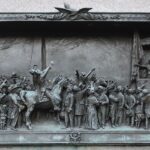“Liberty and union, now and forever, one and inseparable.”
West of Scott Circle, in a small park bound by Bataan Street and Massachusetts and Rhode Island Avenues, stands the monument to Daniel Webster – who may be the most famous orator Senator in U.S. history. Traffic teems on all sides of the monument but few remember him for more than being the protagonist of the short story “The Devil and Daniel Webster.”

The statue was dedicated in January 1900. Nearly every important figure in local and national politics was in attendance, including President William McKinley, his Cabinet, the Justices of the Supreme Court, the Senate and the House of Representatives, the commanding officers of the Army and Navy, and many more.
The monument was paid for by Stilson Hutchins, the founder of the Washington Post. Both Hutchins and Webster were from New Hampshire. The artist chosen for the monument was Gaetano Trentanove, the Italian artist who also sculpted the monument to Confederate general Albert Pike in Judiciary Square. The statue of Webster wears a cape and in its right hand holds a book that rests on a pedestal. On the east and west faces of the base are bronze reliefs of two famous scenes from Webster’s life: on the east face is his reply to South Carolina Senator Robert Y. Hayne, and on the west is his 1825 speech at the fiftieth anniversary of the Battle of Bunker Hill. Both speeches solidified his reputation as an orator.
Webster entered political life in 1812 when he was elected to the House of Representatives from New Hampshire. At the time there was talk of New England seceding from the Union and Webster vigorously opposed the idea. After two terms in office, Webster focused on his law practice. It was at this time that he became known as the foremost constitutional scholar of his generation. He argued over 200 Supreme Court cases, including some of the most important of the time such as Dartmouth College v. Woodward which paved the way for modern corporations.

Daniel Webster was elected to Congress again in 1822, this time from Massachusetts, and spent three terms as a Representative before winning one of that state’s Senate seats. It was during his first term – in 1830 – that the legendary Webster-Hayne debate took place. Hayne argued for state sovereignty. He opposed a tariff then in place to help northeastern manufacturers. He believed that the Constitution was a treaty between the states and that the states could opt out of its laws at any time. Webster was a Unionist; he believed that the Constitution bound the states together, and that the Supreme Court was the ultimate arbiter of the law, not the states. Hayne argued that the liberty of the states came before their unity. Webster argued “Liberty and Union, now and forever, one and inseparable.”
Despite his sterling reputation as a speaker and a Unionist, that reputation would be marred by his infamous Seventh of March speech in which he threw his full support behind the Compromise of 1850. This compromise included the Fugitive Slave Act of 1850, which required the capture and return of runaway slaves in the free northern states. The blowback from this speech was so severe that Webster resigned from the Senate that same year. Ralph Waldo Emerson wrote of him at the time “Why did all manly gifts in Webster fail?/He wrote on Nature’s grandest brow, For Sale.”
Today, Daniel Webster is remembered as the “Expounder of the Constitution.” The cases he argued before the Supreme Court set the direction of the country for the next 100 years, strengthening the power of the federal government in relation to the states. His name and likeness live on in schools, stamps, statues, and cities and counties around the country.

Resources used for this article:
https://en.wikipedia.org/wiki/Daniel_Webster
https://en.wikipedia.org/wiki/Daniel_Webster_Memorial
https://en.wikipedia.org/wiki/Gaetano_Trentanove
https://en.wikipedia.org/wiki/Webster%E2%80%93Hayne_debate
https://en.wikipedia.org/wiki/Compromise_of_1850
http://chroniclingamerica.loc.gov/lccn/sn85054468/1900-01-19/ed-1/seq-9/






One thought on “Daniel Webster”
Comments are closed.